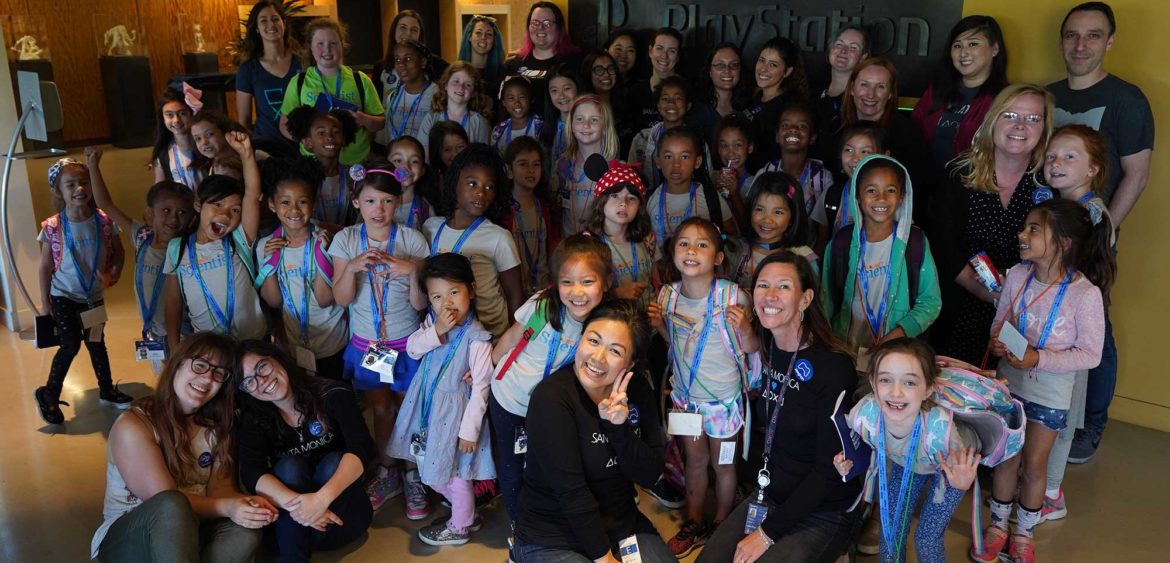Recently, I had the privilege of volunteering alongside other Santa Monica Studio employees to host a group of 37 girls between the ages of 4 and 11 at our studio. We showed them a series of introductory classes into each discipline, including programming, animation, sound, and even suiting up some of them on the mocap stage, in the hopes of igniting interest in and promoting careers in STEM.
It’s no secret that the games industry still has a way to go to reach equality and representation for females (alongside, with the same importance, representation of minority groups and LGBTQ+). It is a topic widely discussed among conferences, articles, interviews, and even in the content of games themselves. It is a topic I also feel strongly about, but I also feel that – having come from a background where STEM was not a class taught in my school, and thus the career option was not something I even considered until much later in my teen years – that we need to go as far back as elementary to start the conversation with new generations and get them interested for the future. It’s not so possible to force equality in our industry by looking to recruit only members of a group, as we still must adhere to equal opportunity for all groups, male or female, minority or majority, and it’s especially hard when the applications received by any one job opening are saturated with male dominated applicants. Is it a case that more males find interest in STEM (and game) jobs than females, and thus pursue them? Is that what then translates into more male applications for a job than female applications? Does that in turn translate to more males working in games than females? We need to go back even further to start that interest in the school level, which will hopefully then turn into more females applying for STEM and game jobs down the line. This does not at all ignore a more serious problem in that someone may be rejected for a job on the basis of gender, cultural, or racial bias, despite having all the skills to fully qualify for the job, but that is blatant discrimination, and is a slightly separate conversation outside of my blog post here.
It was therefore my delight that Santa Monica Studio sought to enthusiastically host these girls for a full day at our studio, allowing them inside the studio to get a peek into how game development works, and hopefully leaving a lasting impression and memory for them to come. For the programming class, we offered an iterative approach to learning with a fun mouse game that showed the girls how programs sequentially implement a series of steps and rules, which we demonstrated by getting the girls to think logically, and then program ahead of time, a robotic mouse to get from an A point (its starting position) to the B point (a block of cheese). Once the girls hit the go button, they would see the mouse move in the order of all the steps they programmed. It was awesome to see how fast the girls caught on to the game, and it was heartfelt to see them take in turns pressing a button to control the mouse’s movement.

Santa Monica Studio wrote their own article on the studio’s blog about the day, including a quote from yours truly. To read more on the Project Scientist initiative, here is a small excerpt from the Santa Monica Studio blog:
Project Scientist began in 2011 with a mission to “expose a diverse population of young girls to a high quality STEM (Science, Technology, Engineering, and Math) academy” that would “ignite and cultivate confidence that a STEM career is attainable for any girl”. Now annually serving more than 2,000 girls on university campuses across the nation, that dream has been fully realized. Alongside other STEM nonprofits such as Code.org, Stem.org, and Girls Who Code, Project Scientist is part of an ever-growing movement to help bridge the gender gaps sometimes found in math and science fields. Associate Producer, Estelle Tigani, who just joined our studio, knows this can thrive at a grassroots level, “It was about starting the creative fundamentals of making games at a young age in an education setting, to inspire that journey in these young women forward to highschool, to college, to study and practice those fundamentals, which turns into the applicant, which can then turn into a higher number of women applying for game development jobs. That turns into stronger diversity.”




Recent Comments